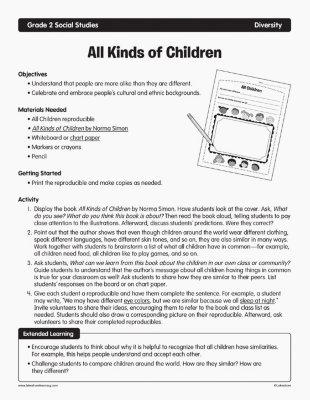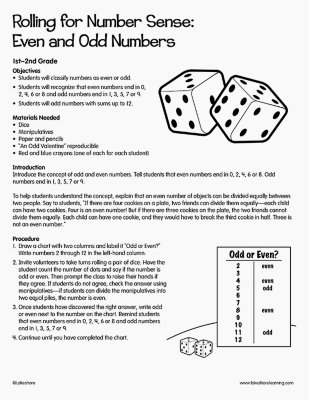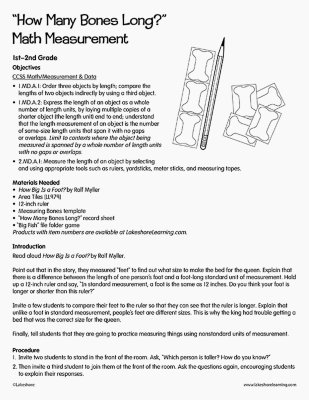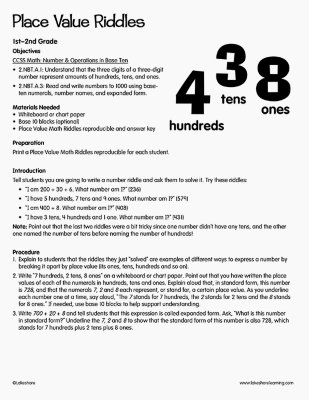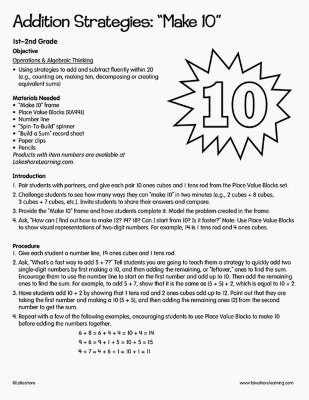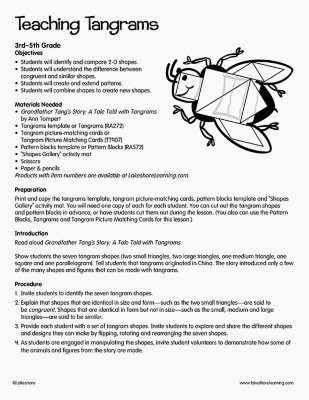Narrow by Grade
- Infant (0)
- Toddler (0)
- Preschool (0)
- Pre-K (0)
- Kindergarten (0)
- 1st (3)
- 2nd (7)
- 3rd (0)
- 4th (0)
- 5th (0)
- 6th & Up (0)
Grade
Narrow by Age
- 0-18m (1)
- 18-36m (1)
- 3 yrs. (0)
- 4 yrs. (5)
- 5 yrs. (6)
- 6 yrs. (13)
- 7 yrs. (7)
- 8 yrs. (5)
- 9 yrs. (5)
- 10 yrs. (5)
- 11 yrs. & Up (0)
Age 7 yrs.
7 results for "block people"
Filters
Clear All
All Kinds of Children
2nd Grade
Objectives
- Understand that people are more alike than they are different.
- Celebrate and embrace people’s cultural and ethnic backgrounds.
Rolling for Number Sense: Even and Odd Numbers
1st Grade - 2nd Grade
Objectives Students will classify numbers as even or odd. Students will recognize that even numbers end in 0, 2, 4, 6 or 8 and odd numbers end in 1, 3, 5, 7 or 9. Students will add numbers with sums up to 12. Materials Needed Dice Manipulatives Paper and pencils “An Odd Valentine” reproducible Red and blue crayons (one of each for each student) Introduction Introduce the concept of odd and even numbers. Tell students that even numbers end in 0, 2, 4, 6 or 8. Odd numbers end in 1, 3, 5, 7 or 9. To help students understand the concept, explain that an even number of objects can be divided equally between two people. Say to students, “If there are four cookies on a plate, two friends can divide them equally—each child can have two cookies. Four is an even number! But if there are three cookies on the plate, the two friends cannot divide them equally. Each child can have one cookie, and they would have to break the third cookie in half. Three is not an even number.”
View Lesson PlanDiversity Poem
2nd Grade
Objectives
- Understand that people have unique experiences, strengths, ideas, and features.
- Think critically and creatively to write a poem.
"How Many Bones Long?" Math Measurement
1st Grade - 2nd Grade
Objectives CCSS Math/Measurement & Data 1.MD.A.1: Order three objects by length; compare the lengths of two objects indirectly by using a third object. 1.MD.A.2: Express the length of an object as a whole number of length units, by laying multiple copies of a shorter object (the length unit) end to end; understand that the length measurement of an object is the number of same-size length units that span it with no gaps or overlaps. Limit to contexts where the object being measured is spanned by a whole number of length units with no gaps or overlaps. 2.MD.A.1: Measure the length of an object by selecting and using appropriate tools such as rulers, yardsticks, meter sticks, and measuring tapes. Materials Needed How Big Is a Foot? by Rolf Myller Area Tiles 12-inch ruler Measuring Bones template “How Many Bones Long?” record sheet “Big Fish” file folder game Introduction Read aloud How Big Is a Foot? by Rolf Myller. Point out that in the story, they measured “feet” to find out what size to make the bed for the queen. Explain that there is a difference between the length of one person’s foot and a foot-long standard unit of measurement. Hold up a 12-inch ruler and say, “In standard measurement, a foot is the same as 12 inches. Do you think your foot is longer or shorter than this ruler?” Invite a few students to compare their feet to the ruler so that they can see that the ruler is longer. Explain that unlike a foot in standard measurement, people’s feet are different sizes. This is why the king had trouble getting a bed that was the correct size for the queen. Finally, tell students that they are going to practice measuring things using nonstandard units of measurement.
View Lesson PlanPlace Value Riddles
2nd Grade
Objectives CCSS Math: Number & Operations in Base Ten 2.NBT.A.1: Understand that the three digits of a three-digit number represent amounts of hundreds, tens, and ones. 2.NBT.A.3: Read and write numbers to 1000 using base-ten numerals, number names, and expanded form. Materials Needed Whiteboard or chart paper Base 10 blocks (optional) Place Value Math Riddles reproducible and answer key Introduction Tell students you are going to write a number riddle and ask them to solve it. Try these riddles: “I am 200 + 30 + 6. What number am I?” (236) “I have 5 hundreds, 7 tens and 9 ones. What number am I?” (579) “I am 400 + 8. What number am I?” (408) “I have 3 tens, 4 hundreds and 1 one. What number am I?” (431) Note: Point out that the last two riddles were a bit tricky since one number didn’t have any tens, and the other one named the number of tens before naming the number of hundreds!
View Lesson PlanAddition Strategies: "Make 10"
1st Grade - 2nd Grade
Objective Operations & Algebraic Thinking Using strategies to add and subtract fluently within 20 (e.g., counting on, making ten, decomposing or creating equivalent sums) Materials Needed “Make 10” frame Place Value Blocks Number line “Spin-To-Build” spinner “Build a Sum” record sheet Paper clips Pencils Introduction Pair students with partners, and give each pair 10 ones cubes and 1 tens rod from the Place Value Blocks set. Challenge students to see how many ways they can “make 10” in two minutes (e.g., 2 cubes + 8 cubes, 3 cubes + 7 cubes, etc.). Invite students to share their answers and compare. Provide the “Make 10” frame and have students complete it. Model the problem created in the frame. Ask, “How can I find out how to make 12? 14? 18? Can I start from 10? Is it faster?” Note: Use Place Value Blocks to show visual representations of two-digit numbers. For example, 14 is 1 tens rod and 4 ones cubes.
View Lesson PlanTeaching Tangrams
2nd Grade
Objectives Students will identify and compare 2-D shapes. Students will understand the difference between congruent and similar shapes. Students will create and extend patterns. Students will combine shapes to create new shapes. Materials Needed Grandfather Tang’s Story: A Tale Told with Tangrams by Ann Tompert Tangrams template or Tangrams Tangram picture-matching cards or Tangram Picture Matching Cards Pattern blocks template or Pattern Blocks “Shapes Gallery” activity mat Scissors Paper & pencils Preparation: Print and copy the tangrams template, tangram picture-matching cards, pattern blocks template and “Shapes Gallery” activity mat. You will need one copy of each for each student. You can cut out the tangram shapes and pattern blocks in advance, or have students cut them out during the lesson. (You also can use the Pattern Blocks, Tangrams and Tangram Picture Matching Cards for this lesson.) Introduction Read aloud Grandfather Tang’s Story: A Tale Told with Tangrams. Show students the seven tangram shapes (two small triangles, two large triangles, one medium triangle, one square and one parallelogram). Tell students that tangrams originated in China. The story introduced only a few of the many shapes and figures that can be made with tangrams.
View Lesson Plan